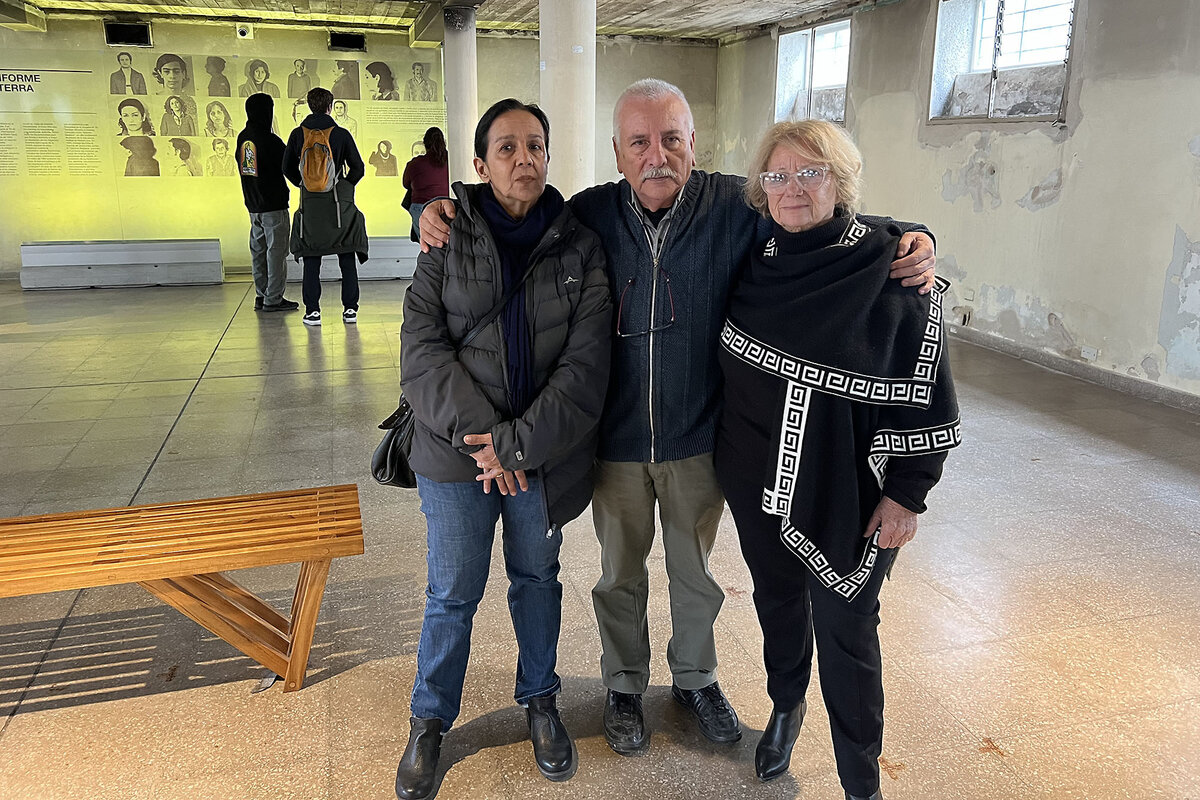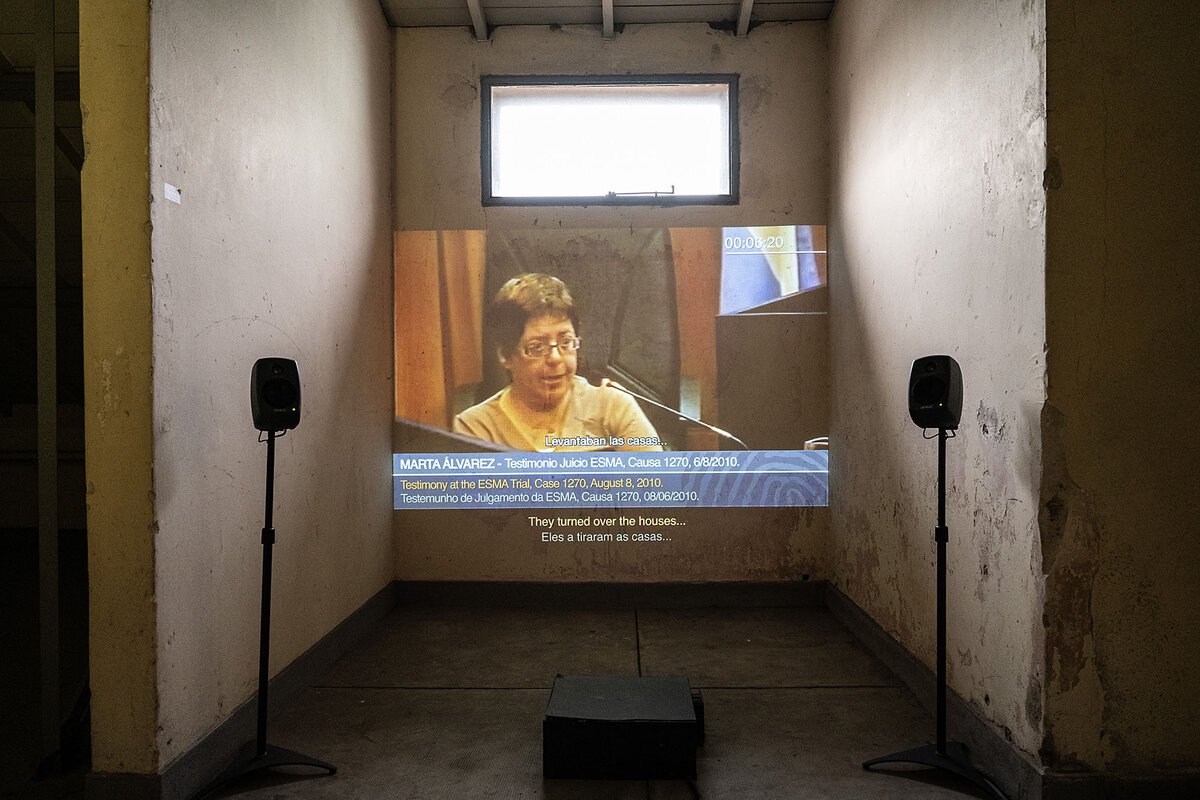Reframing a dictatorship: Argentine human rights museum under fire
Loading...
| Buenos Aires, Argentina
Ana María Soffiantini, a retired school principal and grandmother of 13, indicates with a sweep of her hand the cramped, dark space where she was held captive nearly five decades ago.
In 1977, when both she and her husband were part of a leftist revolutionary organization, they were kidnapped by Argentina’s brutal military dictatorship for “subverting” the government. She was detained at the notorious Navy School of Mechanics (ESMA) for a year, with a hood over her head and chains on her ankles.
“While lying here we listened to every sound, we kept track of every movement to try to figure out where we were and what was going on around us,” Ms. Soffiantini recalls.
Why We Wrote This
Who gets to write history? That’s the question in Argentina where decades of well-documented crimes and court hearings are being questioned by the nation’s new populist, libertarian leadership.
She was one of more than 5,000 labor organizers, leftist Catholics, and student activists grabbed from their homes and the streets and held at ESMA between 1976 and 1983. Only a few hundred came out alive.
Argentina has made a name for itself in a region that was wracked by bloody coups and military dictatorships; it’s a reputation based not only on some of the junta’s brazen crimes, like kidnapping prisoners’ babies and offering them for adoption to military families, but also because of subsequent governments’ work to hold people accountable for state-led terror. Argentina has tried more than 300 cases of dictatorship-related crimes against humanity since 2006, with many still in adjudication.
Today, the once notorious detention and torture center where Ms. Soffiantini was held is a museum and memorial, open to the public since 2015. Last year it was named a UNESCO World Heritage Site, one of the few venues from recent history to figure on the organization’s list. But within weeks of ESMA’s designation as a space of global historic importance came the election of right-wing populist President Javier Milei.
Mr. Milei and especially his vice president, Victoria Villarruel, are outspoken about what they see as a one-sided narrative about the military dictatorship, bolstered by institutions like the ESMA Museum and Memory Site. Both of them have taken steps to halt investigations into dictatorship-era crimes, and Ms. Villarruel, daughter of a prominent military family, questions the commonly accepted estimate that 30,000 people were killed during the dictatorship. She has also organized visits to imprisoned officers convicted of crimes against humanity.
The president and his allies’ skepticism about Argentina’s documented history has opened the gates to fresh and bitter questioning of how the dictatorship – and torture sites like ESMA – should be remembered.
Argentina is facing “intense debate over what has been a widely accepted depiction of a painful historical period,” says Ernesto Verdeja, an associate professor of peace studies at the University of Notre Dame in Indiana. He says that is reopening “what seemed settled questions about who was right and who was wrong ... and how society should view its past” and try to build its future.
“Sites like ESMA represent much more than what happened inside them,” Dr. Verdeja says.
New elections, new history?
Between 1976 and 1983 Argentina’s military dictatorship carried out a violent, repressive campaign against suspected left-wing political opponents. It took place in the global context of the Cold War, when powerful countries such as the United States heightened fears of communist takeovers, particularly in Latin America.
It was from ESMA, part of a sprawling military complex on a leafy boulevard in one of Buenos Aires’ tonier neighborhoods, that the military dictatorship carried out its notorious “death flights.” Detainees were taken up in small planes and pushed to their deaths from the open rear hatch into the sea below. The flights gave the world the transitive verb “to disappear” someone.
The emergence of a different historical narrative, seeking to highlight the dangers posed by leftist groups, is closely linked to the rise of new political powers, says Dr. Verdeja.
“The rejection of what has long been accepted truth is very much driven by domestic politics, by a sense of national crisis,” he says.
Vice President Villarruel has long argued that the military was fighting a legitimate civil war to save Argentina from Marxist rule. Since her election alongside Mr. Milei she has championed efforts to rehabilitate the armed forces’ reputation.
Her robust defense of the dictatorship strikes many Argentines as exaggerated. But, a growing number of conservatives say that after four decades of a single, one-sided presentation of what happened under military rule, it is indeed time for a closer look.
“Unbelievable”
Back at the ESMA museum, Director Mayki Gorosito is adamant that its purpose is not to interpret events, but to chronicle the crimes committed by a state against its own people.
“We present the facts of what took place here based on the record of the testimonies given in the many cases and the judgments of courts of law,” she says. “It would be dangerous for democracy ... to lose that focus on the crimes committed during state-practiced terrorism.”
As she speaks, high school groups and other visitors walk around the floors above, where detainees were held, and where some were forced to produce dictatorship propaganda. Monitors play excerpts from the court testimony of both ESMA workers and their victims.
In the basement, three high school boys stand in the doorway through which detainees were taken to the planes from which they would be pushed to their death.
“Unbelievable,” one boy whispers to his friend.
Even if Ms. Gorosito’s mission is simply to demonstrate that what happened at ESMA is fact, proven in court, she must be cautious, she says. Not only is she managing a tinderbox of historical memories, but her museum is threatened by the same austerity cuts that the new government has imposed on all government agencies.
Mr. Milei rode into office on a wave of discontent over Argentina’s hyperinflation, stagnant economy, and rising poverty. He has proceeded with drastic steps such as eliminating many ministries and slashing the budgets of those remaining.
The ESMA “site itself is not threatened,” says Horacio Pietragalla, a former secretary of human rights. “What is threatened by budget cuts is all the research that continues into the crimes of the era.”
Mr. Pietragalla is a dictatorship-era kidnapping victim himself, placed with a military-related family after his birth parents were killed in clashes with police. He says he is afraid that the government is trying to “erase” history by gutting the institutions that have established the facts of a dark past.
Ms. Gorosito, the museum director, actually quit her job when Mr. Milei took office last December. She was persuaded to return, but only on condition that none of the existing staff be fired, that support for ESMA survivors continue, and, perhaps most critically, that none of the exhibits in the museum be modified or removed.
Ms. Soffiantini, the torture survivor detained at ESMA, has a simple explanation for the difference between her experience and the government’s “very different perspective. History is always written by the winners. And they have won,” she says of Mr. Milei’s party. “So they want their history.”









